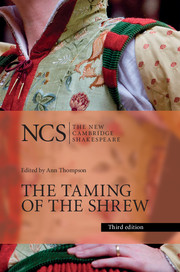Book contents
- The New Cambridge Shakespeare
- The New Cambridge Shakespeare
- The Taming of the Shrew
- Copyright page
- The New Cambridge Shakespeare
- Dedication
- Contents
- Illustrations
- Preface to the Third Edition
- Abbreviations and Conventions
- Introduction
- Note on the text
- The Taming of the Shrew
- Textual analysis
- Book part
- Reading List
- References
Reading List
Published online by Cambridge University Press: 16 August 2019
- The New Cambridge Shakespeare
- The New Cambridge Shakespeare
- The Taming of the Shrew
- Copyright page
- The New Cambridge Shakespeare
- Dedication
- Contents
- Illustrations
- Preface to the Third Edition
- Abbreviations and Conventions
- Introduction
- Note on the text
- The Taming of the Shrew
- Textual analysis
- Book part
- Reading List
- References
- Type
- Chapter
- Information
- The Taming of the Shrew , pp. 207 - 209Publisher: Cambridge University PressPrint publication year: 2017

